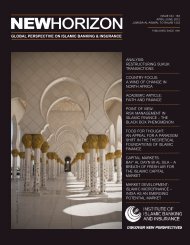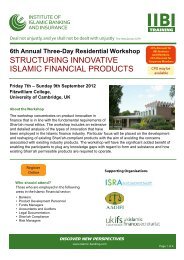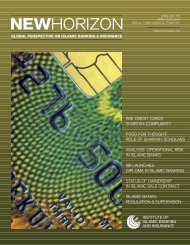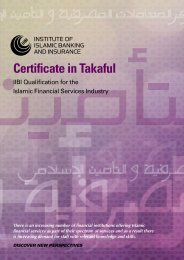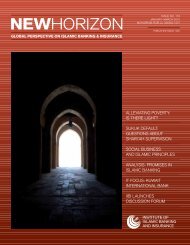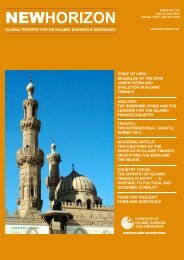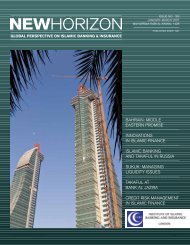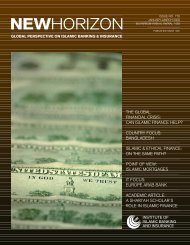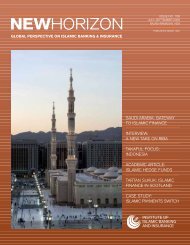azerbaijan: emerging market islamic banking and finance
azerbaijan: emerging market islamic banking and finance
azerbaijan: emerging market islamic banking and finance
Create successful ePaper yourself
Turn your PDF publications into a flip-book with our unique Google optimized e-Paper software.
NEWHORIZON Shawwal–Dhu Al Hijjah 1429<br />
INNOVATION SPOTLIGHT<br />
Islamic wealth management industry over<br />
the next several years.<br />
These strategies should be transparent <strong>and</strong><br />
made available in the form of capitalprotected<br />
certificates which, in the event of<br />
a collapse of the issuer or a malfunction of<br />
the strategy, have the ability to offer 100<br />
per cent redemption by adopting a strict<br />
segregation of the Islamic principal via an<br />
Islamic trust, which in turn invests in<br />
Shari’ah-compliant assets only. This<br />
certificate must be offered at competitive<br />
levels in an attempt to rival their<br />
conventional counterparts <strong>and</strong> be made<br />
available in the secondary <strong>market</strong> at<br />
reasonable bid/offer spreads. Target<br />
investors should include retail, private <strong>and</strong><br />
institutional clients.<br />
One such Islamic dynamic strategy is the<br />
‘Islamic Navigator’, which invests in four<br />
Shari’ah-compliant assets based on an<br />
algorithm that identifies medium-term<br />
trends in these assets. The trend is identified<br />
by comparing the prevailing spot price of<br />
the asset to its recent moving average. The<br />
length of the moving average may vary for<br />
each asset <strong>and</strong> can be optimised based on<br />
historical simulations. Should the algorithm<br />
detect a positive trend (i.e. when spot price<br />
is above the moving average) for an asset,<br />
a fixed allocation is provided to that asset.<br />
In the event of a negative trend being<br />
detected, the allocation for the asset is<br />
directed to a commodity-based reserve asset.<br />
The shift in these weightings is conducted<br />
on a monthly basis. The initial result is a<br />
dynamic index linked to a number of<br />
underlying assets.<br />
The strategy is then controlled through a<br />
volatility stabilisation mechanism, which<br />
employs a ‘dynamic participation’ level<br />
based on the volatility of the initial index.<br />
Should the index observe high short-term<br />
volatility, the mechanism reduces exposure<br />
to the index, <strong>and</strong> vice versa. In effect, the<br />
strategy targets a certain st<strong>and</strong>ard deviation<br />
from the average daily returns by decreasing<br />
or increasing the exposure to the index.<br />
Hence, the volatility is ex ante defined <strong>and</strong><br />
is measurable at the outset, which is unusual<br />
for Islamic strategies.<br />
The result is a transparent, Shari’ahcompliant,<br />
low volatility strategy which<br />
provides stable returns. A simple historical<br />
simulation of the Islamic Navigator<br />
vindicates the attractive risk-return profile<br />
this strategy offers. Since January 2002, the<br />
Islamic Navigator has provided an IRR<br />
(internal rate of return) of approximately<br />
13.6 per cent p.a. with an annualised<br />
volatility of only seven per cent. This<br />
compares favourably against the Dow Jones<br />
Islamic Market Index, which during the<br />
same period provided an IRR of<br />
approximately 7.2 per cent p.a. with an<br />
annualised volatility of around 14 per cent<br />
(see the graphs below).<br />
The goal of Islamic dynamic strategies is to<br />
develop low risk but stable return strategies<br />
that do not suffer from the same issues as<br />
Islamic hedge fund investments. Historical<br />
simulations of strategies such as the Islamic<br />
Navigator indicate that they have been<br />
largely successful in achieving these goals.<br />
This provides an excellent addition to<br />
Islamic portfolios which have traditionally<br />
missed this ‘quadrant’ on the risk-return<br />
profile of their investments.<br />
www.newhorizon-<strong>islamic</strong><strong>banking</strong>.com IIBI 15



